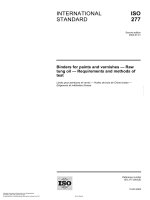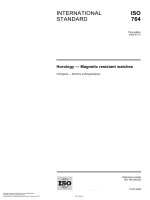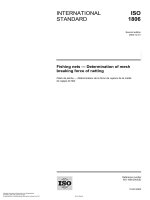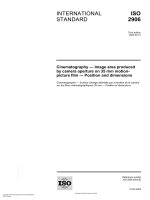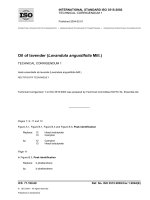Tiêu chuẩn iso 15629 2002
Bạn đang xem bản rút gọn của tài liệu. Xem và tải ngay bản đầy đủ của tài liệu tại đây (446.49 KB, 22 trang )
INTERNATIONAL
STANDARD
ISO
15629
First edition
2002-11-01
Pallets for materials handling — Quality of
fasteners for assembly of new and repair of
used, flat, wooden pallets
Palettes pour la manutention et le transport de marchandises — Qualité des
éléments de fixation pour l'assemblage et la réparation des palettes en bois
Reference number
ISO 15629:2002(E)
© ISO 2002
--`,,,`-`-`,,`,,`,`,,`---
Copyright International Organization for Standardization
Provided by IHS under license with ISO
No reproduction or networking permitted without license from IHS
Not for Resale
ISO 15629:2002(E)
PDF disclaimer
This PDF file may contain embedded typefaces. In accordance with Adobe's licensing policy, this file may be printed or viewed but shall not be
edited unless the typefaces which are embedded are licensed to and installed on the computer performing the editing. In downloading this file,
parties accept therein the responsibility of not infringing Adobe's licensing policy. The ISO Central Secretariat accepts no liability in this area.
Adobe is a trademark of Adobe Systems Incorporated.
--`,,,`-`-`,,`,,`,`,,`---
Details of the software products used to create this PDF file can be found in the General Info relative to the file; the PDF-creation parameters
were optimized for printing. Every care has been taken to ensure that the file is suitable for use by ISO member bodies. In the unlikely event
that a problem relating to it is found, please inform the Central Secretariat at the address given below.
© ISO 2002
All rights reserved. Unless otherwise specified, no part of this publication may be reproduced or utilized in any form or by any means,
electronic or mechanical, including photocopying and microfilm, without permission in writing from either ISO at the address below or ISO's
member body in the country of the requester.
ISO copyright office
Case postale 56 • CH-1211 Geneva 20
Tel. + 41 22 749 01 11
Fax + 41 22 749 09 47
Web www.iso.ch
Printed in Switzerland
ii
Copyright International Organization for Standardization
Provided by IHS under license with ISO
No reproduction or networking permitted without license from IHS
© ISO 2002 – All rights reserved
Not for Resale
ISO 15629:2002(E)
Foreword
ISO (the International Organization for Standardization) is a worldwide federation of national standards bodies (ISO
member bodies). The work of preparing International Standards is normally carried out through ISO technical
committees. Each member body interested in a subject for which a technical committee has been established has
the right to be represented on that committee. International organizations, governmental and non-governmental, in
liaison with ISO, also take part in the work. ISO collaborates closely with the International Electrotechnical
Commission (IEC) on all matters of electrotechnical standardization.
International Standards are drafted in accordance with the rules given in the ISO/IEC Directives, Part 3.
Attention is drawn to the possibility that some of the elements of this International Standard may be the subject of
patent rights. ISO shall not be held responsible for identifying any or all such patent rights.
International Standard ISO 15629 was prepared by Technical Committee ISO/TC 51, Pallets for unit load method of
materials handling.
Annexes A, B and C of this International Standard are for information only.
Copyright International
Organization
Standardization
© ISO
2002 –forAll
rights reserved
Provided by IHS under license with ISO
No reproduction or networking permitted without license from IHS
iii
Not for Resale
--`,,,`-`-`,,`,,`,`,,`---
Draft International Standards adopted by the technical committees are circulated to the member bodies for voting.
Publication as an International Standard requires approval by at least 75 % of the member bodies casting a vote.
ISO 15629:2002(E)
Introduction
Efficient international transportation of products depends on both pallet strength and functionality, or fit, to the
materials handling systems. Existing ISO standards address issues of strength and some issues regarding
functionality of pallets. However, major issues related to the minimum material quality and manufacturing and repair
workmanship are not addressed in current ISO standards. These factors may significantly impact the efficiency of
international unit-load material handling.
In November, 1996, ISO TC 51 approved a new work item “Timber Pallets for Materials Handling — Quality of
Component Assembly and Repair” and established WG 7 to prepare a document.
This International Standard contains recommended minimum acceptable quality levels for mechanical fasteners
used in the assembly of wooden pallets. Mechanical fasteners commonly used for the assembly of wooden pallets
are classified as nails, staples, bolts and screws. The type and properties of fasteners affect pallet performance.
This International Standard does not address safety problems, if any, associated with the use of these fasteners. It is
the responsibility of the user of this International Standard to establish appropriate safety and health practices and
determine the applicability of regulatory limitations prior to use.
This document addresses the current commercial difficulty in pallet manufacture, that there is no recognized means
of defining pallet nails with regard to their quality and strength. Table 2 gives a guide as to strength qualities for nails
which are typically used in construction of very strong pallets as opposed to pallets designed for light loads.
Actual nail diameter, profiles and strengths are the responsibility of the specifier and user who may find the full-scale
pallet tests described in ISO 8611-1 of value.
In September 1999 it was decided to publish four related International Standards:
— ISO 15629:2002, Pallets for materials handling — Quality of fasteners for assembly of new and repair of used,
flat, wooden pallets
— ISO 18333, Pallets for materials handling — Quality of new wooden components for flat pallets
— ISO 18334, Pallets for materials handling — Quality of assembly of new, wooden, flat pallets
— ISO 18613, Repair of flat wooden pallets
--`,,,`-`-`,,`,,`,`,,`---
iv
Copyright International Organization for Standardization
Provided by IHS under license with ISO
No reproduction or networking permitted without license from IHS
© ISO 2002 – All rights reserved
Not for Resale
INTERNATIONAL STANDARD
ISO 15629:2002(E)
Pallets for materials handling — Quality of fasteners for assembly
of new and repair of used, flat, wooden pallets
1 Scope
This International Standard gives guidelines on nails and staples used in the assembly of new and repair of used
wooden flat pallets.
For the purposes of this International Standard the term fasteners applies to nails and staples only.
This International Standard is prescriptive and performance-based and contains physical descriptions of fasteners as
well as minimum recommended performance levels.
For information on other fasteners such as bolts and screws used in pallets, see ISO 445.
2 Normative references
The following normative documents contain provisions which, through reference in this text, constitute provisions of
this International Standard. For dated references, subsequent amendments to, or revisions of, any of these
publications do not apply. However, parties to agreements based on this International Standard are encouraged to
investigate the possibility of applying the most recent editions of the normative documents indicated below. For
undated references, the latest edition of the normative document referred to applies. Members of ISO and IEC
maintain registers of currently valid International Standards.
ISO 445, Pallets for materials handling — Vocabulary
ISO 12777-1, Methods of test for pallet joints — Part 1: Determination of bending resistance of pallet nails, other
dowel-type fasteners and staples
ISO 12777-2, Methods of test for pallet joints — Part 2: Determination of withdrawal and head pull-through
resistance of pallet nails and staples
3 Terms and definitions
For the purposes of this International Standard, the terms and definitions given in ISO 445 apply together with the
following.
3.1
fluted nail
round wire nail with thread-crests parallel to the nail shank
4 Nails and Staples
4.1 Classification
As used in pallets, nails are classified as plain- or smooth-shank, helical, annular ring, twisted or barbed. Staples
have either round-wire or approximately square-wire legs, referring to the cross-sectional shape of the wire. Nails
and staples shall be specified using at least nail wire diameter, length, thread type and point type. These and other
characteristics which affect pallet nail and staple performance are listed in Table 1.
--`,,,`-`-`,,`,,`,`,,`---
Copyright International
Organization
Standardization
© ISO
2002 –forAll
rights reserved
Provided by IHS under license with ISO
No reproduction or networking permitted without license from IHS
1
Not for Resale
ISO 15629:2002(E)
Table 1 — Physical and mechanical characteristics of nails and staples used in pallets
Nails — Shank profiles
Plain (smooth)
Helical
Annular
Square twisted —
barbed
Round wire
Square wire
Length nail (wire)
diameter
Length nail (wire)
diameter
Length nail (wire)
diameter
Length nail (wire)
diametera
Length staple leg
diameter
Length Staple leg
width and thickness
Head diameter
Head diameter
Head diameter
Head diameter
Crown length
Crown length
—
Thread length
Thread length
—
—
—
—
Thread-crest
diameter
Thread-crest
diameter
Flute-crest diameter
—
—
—
Number of helixes
Number of rings
Number of helixes
—
—
—
Number of flutes
—
Number of flutes
—
—
Type of point
Type of point
Type of point
Type of point
Type of point
Bending resistance Bending resistance Bending resistance
a
Staples
Type of point
Bending resistance
Bending resistance Bending resistance
The nail (wire) diameter is the thread crest diameter.
4.2 Measurement of physical characteristics
Methods of measuring the physical characteristics of nails and staples are described in annex A. When a complete
assessment of fastener quality is required, separation resistance in accordance with ISO 12777-2 shall be
determined by measuring both fastener shank withdrawal and head or crown pull-through. These tests shall include
using wood specimens and specimen conditioning typical of those which occur during pallet use.
4.3 Minimum acceptable performance
The recommended minimum acceptable performance levels for nails and staples are specified in Table 2. Annex B is
a correlation between the static bending resistance values reported in Table 2 and the MIBANT impact bend test as
described in ISO 12777-1.
NOTE 1 Tests of joints containing multiple fasteners are described in ISO 12777-3.
NOTE 2 Pallet fasteners are sometimes coated. These coatings are intended to:
— increase corrosion resistance;
— improve separation resistance;
— improve drivability.
--`,,,`-`-`,,`,,`,`,,`---
The effect of coatings on fastener performance shall be evaluated using tests described in ISO 12777-2.
2
Copyright International Organization for Standardization
Provided by IHS under license with ISO
No reproduction or networking permitted without license from IHS
© ISO 2002 – All rights reserved
Not for Resale
ISO 15629:2002(E)
Table 2 — Recommended minimum quality of staples and nailsa
Minimum separation
resistanceb per fastener
Performance leveld
Minimum bending
resistancec per fastener
Minimum ratio
of nail head/nail
(wire) diameter
Minimum staple
crown length
1
2
3
1
2
3
Block or stringer
fasteners
2 000 N
1 000 N
600 N
6,0 N·m
5,4 N·m
3,5 N·m
2,00
9,5 mm + 2 ×
(leg width or diameter)
Clinched mat
fasteners
1 000 N
500 N
250 N
2,5 N·m
2,2 N·m
1,6 N·m
2,00
9,5 mm + 2 ×
(leg width or diameter)
a
The quality levels represent those of pallet fasteners successfully used. It is the responsibility of the pallet specifier to determine the
appropriate fastener quality necessary for use.
b
Determined in accordance with ISO 12777-2 by measuring both fastener shank withdrawal and head or crown pull-through resistance.
c
Determined in accordance with ISO 12777-1.
d
--`,,,`-`-`,,`,,`,`,,`---
Performance level refers to relative levels of pallet structural durability or resistance to rough handling during pallet use. Levels 1, 2, and 3
refer to fastener quality levels for use in reusable pallets of respectively high, medium and low levels of structural durability.
Copyright International
Organization
Standardization
© ISO
2002 –forAll
rights reserved
Provided by IHS under license with ISO
No reproduction or networking permitted without license from IHS
3
Not for Resale
ISO 15629:2002(E)
Annex A
(informative)
Methods of measuring pallet nail and staple physical characteristics
A.1 Sampling
A random sample of at least twelve (12) specimens per “lot” of fasteners is recommended. Average values and an
appropriate measure of statistical dispersion should be reported.
NOTE A “lot” consists of fasteners of a single shipment of the same specification and produced during a single continuous
production run.
A.2 Fastener length
A.2.1 Nails
The nail length (l) is the distance, measured parallel to the nail-shank axis, from the top of the head to the tip of the
point, as shown in Figure A.1. For this measurement, a caliper or ruler is used to measure to the nearest 0,5 mm.
Figure A.1 — Schematic diagram of nail length measurement
A.2.2 Staples
The staple length (L) is the distance, measured parallel to the staple-leg axis, from the bottom of the crown to the tip
of the point, as shown in Figure A.2. For this measurement, a caliper or ruler is used to measure to the nearest
0,5 mm.
A.3 Thread length
The thread length (LT ) is the continuous distance from the top end of the thread along the nail shank to the top of the
point or the bottom end of the thread, as shown in Figure A.3. If the thread is not continuous, i.e. interrupted, the
thread length is the length of the threaded portions of the nail shank penetrating the nailing member to the required
depth. The thread length is measured with a caliper or ruler to the nearest 0,5 mm.
A.4 Nail or staple wire diameter
A.4.1 Plain, helical barbed and annular round-wire nails
The wire diameter (d) is the distance across the non-threaded portion of the nail shank away from the gripper marks,
as shown in Figure A.4. The wire diameter is measured using a micrometer to the nearest 0,025 mm. If the nail is
coated, the coating should be carefully removed where the measurement is to be made.
--`,,,`-`-`,,`,,`,`,,`---
4
Copyright International Organization for Standardization
Provided by IHS under license with ISO
No reproduction or networking permitted without license from IHS
© ISO 2002 – All rights reserved
Not for Resale
ISO 15629:2002(E)
--`,,,`-`-`,,`,,`,`,,`---
Figure A.2 — Schematic diagram of the staple length measurement
Figure A.3 — Schematic diagram of the thread length measurement
Key
A
B
Plain shank
Helically threaded
C
Annularly threaded
Wire diameter
d1
d2
Thread diameter
Figure A.4 — Schematic diagram of nail wire diameter (d) measurements
Copyright International
Organization
Standardization
© ISO
2002 –forAll
rights reserved
Provided by IHS under license with ISO
No reproduction or networking permitted without license from IHS
5
Not for Resale
ISO 15629:2002(E)
A.4.2 Staples
The wire diameter of both staple legs is the same. For round-wire bulk staples, it is the distance across one of the
staple legs. For flattened-wire staples, usually having a rectangular cross-section, the corresponding measurements
are the thickness (T ) and the width (W ) of the staple leg, as shown in Figure A.5. The thickness is the wire
dimension in the direction perpendicular to the staple crown. The thickness is normally the largest cross-sectional leg
dimension. The width is the wire dimension in the direction parallel to the staple crown. Both thickness and width are
measured to the nearest 0,025 mm, along the uncoated portion of the staple leg, using a micrometer.
Figure A.5 — Schematic diagram of the measurement of staple width and thickness
A.4.3 Fluted or twisted square shank nails
For fluted or twisted square shank nails, the nail wire diameter (d) is to be the thread crest diameter, as shown in
Figure A.6. Fluted nails are formed by drawing round wire through a threading die.
Key
A
B
Square wire twisted shank
Square wire fluted shank
d2
Diameter
--`,,,`-`-`,,`,,`,`,,`---
Figure A.6 — Schematic diagram of the wire diameter measurement for fluted or twisted square shank nails
6
Copyright International Organization for Standardization
Provided by IHS under license with ISO
No reproduction or networking permitted without license from IHS
© ISO 2002 – All rights reserved
Not for Resale
ISO 15629:2002(E)
A.5 Thread-crest diameter
A.5.1 Fluted, twisted and threaded nails
The thread-crest diameter (DT ) of fluted, twisted, and threaded nails is the distance from crest to crest along the
deformed portion of the nail shank, as shown in Figure A.7. It is measured in the direction perpendicular to the nail
axis, to the nearest 0,025 mm, using a flat-spindle micrometer. To account for any non-uniformity or taper of the
shank deformations, measurements should be made at least at three locations, that is near the two ends and along
the centre of the flutes or threads while rotating the nail. Thread crests should be sharp and not rounded.
Key
B
Helically threaded shank
C
DT
Annularly threaded shank
Thread-crest diameter
Figure A.7 — Schematic diagram of the thread crest diameter measurement
A.5.2 Individual nail
The thread-crest diameter (DT ) of an individual nail is the average of at least three measurements. This diameter
may vary considerably for nails taken from a single sample or from a lot of nails as well as from several lots of nails
of the same shipment.
A.6 Thread helixes
A.6.1 Helically threaded round-wire nails
--`,,,`-`-`,,`,,`,`,,`---
For helically threaded round-wire nails, the number of helixes of helically threaded round-wire nails is the number of
major thread crossings along the full thread length. Major threads are those threads in double thread-crest nails
where the major and minor threads are located close and parallel to each other. Using a nail with a thread diameter
equal to the average thread diameter of the sample and placing a ruler along the thread parallel to the nail axis, as
shown in Figure A.8, count the number of thread crests (or projected thread crests in the case of a tapered thread).
The number of helixes can be obtained by dividing the number of thread contacts by the exact length over which they
were counted and multiplying the resulting value by the total thread length. This value should be rounded off to the
nearest 0,1 helix.
Copyright International
Organization
Standardization
© ISO
2002 –forAll
rights reserved
Provided by IHS under license with ISO
No reproduction or networking permitted without license from IHS
7
Not for Resale
ISO 15629:2002(E)
Key
A
Number of thread contacts
Number of helixes = (7 thread contacts/1,9 cm thread length) × 3 cm
Figure A.8 — Schematic diagram of the number of helixes in a threaded nail
A.6.2 Twisted square-wire or fluted nails
--`,,,`-`-`,,`,,`,`,,`---
For twisted square-wire nails, the flutes of twisted square-wire nails or fluted nails extend the entire length of the nail
shank from the point to the underside of the head. The determination of the number of helixes of twisted square-wire
nails should be the same as that for helically threaded round-wire nails, as shown in Figure A.9.
Key
A
Number of thread contacts
Number of helixes = (4 thread contacts/2,4 cm thread length) × 3 cm
Figure A.9 — Schematic diagram of the number of helixes in a twisted square wire nail
A.7 Thread rings — Annularly threaded nails
For annularly threaded nails, the number of major thread rings along the nail shank should be counted and recorded.
Major thread rings are those thread rings in double thread-crest nails where the major and minor thread rings are
close and parallel to each other, as shown in Figure A.10. To determine the number of rings per inch along the
threaded portion of the nail shank, the number of major thread rings should be counted and divided by the thread
length. Since there is usually little variation in the number of major rings within a sample or lot of annularly threaded
nails, the examination of five fasteners is sufficient to obtain a reliable value for the number of rings.
Key
1 2 3 4 5 ... = count of major thread rings
Figure A.10 — Schematic diagram of the major thread rings in annularly threaded nails
8
Copyright International Organization for Standardization
Provided by IHS under license with ISO
No reproduction or networking permitted without license from IHS
© ISO 2002 – All rights reserved
Not for Resale
ISO 15629:2002(E)
A.8 Thread flutes
A.8.1 Helically threaded and twisted square-wire nails
For helically threaded and twisted square-wire nails, the number of flutes along the nail shank can be observed by
looking at the point end of the nail and counting the major depressions along the surface or of the cross-section of
the nail shank, as shown in Figure A.11. The twisted square-wire nail has four flutes. The helically threaded nail
normally has four or five flutes. For special nails and, particularly, for stout nails, the use of a larger number of flutes
may occur.
Square twisted shank
B
a
Helically threaded shank
4 flutes
b
5 flutes
--`,,,`-`-`,,`,,`,`,,`---
Key
A
Figure A.11 — Schematic diagrams of flutes in threaded nails
A.8.2 Variation of the number of flutes
Variations in the number of flutes can be found within a sample of helically threaded nails. Therefore, all nails of a
sample of threaded nails should be examined for the number of flutes along the shank. The thread angle should be
computed for each nail with a different number of flutes.
A.9 Thread angle
For helically threaded round-wire and twisted square-wire nails, the thread angle (αT ) is measured relative to a plane
perpendicular to the axis of the nail shank, as shown in Figure A.12. This angle can be measured using a protractor
from the carbon impression obtained after having the nail shank rolled over a sheet of carbon paper. However, more
consistent angle values can be obtained by computing the average thread angle, αT , in degrees, using a calculator
which is programmed in line with the following equation:
αT = arctan {F / [DT × π × (N/LT )]}
where
F
is the number of flutes along the nail shank;
DT
is the average thread-crest diameter, in millimetres;
N
is the number of helixes along the nail shank;
LT
is the thread length, in millimetres;
arctan is the arctangent.
The thread-angle value should be rounded off to the nearest degree.
Copyright International
Organization
Standardization
© ISO
2002 –forAll
rights reserved
Provided by IHS under license with ISO
No reproduction or networking permitted without license from IHS
9
Not for Resale
ISO 15629:2002(E)
If any variation in the number of thread flutes is observed within a sample or lot, the thread angle should be computed
for each nail having a different number of flutes by inputting the appropriate number of helixes for each number of
flutes.
The thread angle (αT ) is sometimes expressed as slope (S ). The thread slope is the slope of the line formed by the
thread relative to the axis of the fastener shank.
Figure A.12 — Schematic diagram of the thread angle of a helically threaded nail
A.10 Point length
The length of the nail and staple points (LP ), measured along the edge of the point, extends from the top of the point
to its bottom end or tip, as shown in Figure A.13. A blunt or dull point has a round point end, in contrast to a sharp
point which has a keen point end. The pallet fastener may be pointless as a result of shearing the fastener wire at a
right angle to the wire axis during the fastener's manufacture. The pallet-nail and pallet-staple point should not
exceed 5 mm.
Figure A.13 — Schematic diagram of the point length measurement
A.11 Nail-head diameter (DH ) and head-rim thickness (TH )
A.11.1 The head of a pallet nail should be flat or chequered and slightly countersunk. It should be concentric or
nearly concentric. The head diameter (DH ) is the maximum distance across the nail head perpendicular to the nail
axis. In the case of an oval- or square-shaped head, the head diameter is the maximum measurement, as shown in
Figure A.14. They can be measured, using a micrometer, to the nearest 0,025 mm. This permits the determination of
the nail-head size by using a metal gauging device with a number of nail holes representative of common nail-head
sizes. If the nail head can be pushed through a nail hole of a certain size, the nail-head size is smaller than that
representative of the particular hole size; and if the nail head cannot be pushed through a nail hole, the nail-head size
10
Copyright International Organization for Standardization
Provided by IHS under license with ISO
No reproduction or networking permitted without license from IHS
© ISO 2002 – All rights reserved
Not for Resale
--`,,,`-`-`,,`,,`,`,,`---
NOTE The most common type of point is the diamond point, a symmetrical point having four approximately equal bevelled
planes which form a pyramid. For pallet nails and staples, chisel and wedge points are often specified. The chisel point is a point
with two major planes forming a “V” and a pair of minor planes on each shank, forming a hexagonal cross-section. In contrast, the
wedge point has two convergent planes forming a “V”, and the tapered wedge point has two major planes forming a “V” and a
single minor plane on each flank forming a rectangular cross-section. Nail points, intended for clinching, have asymmetric points
offset to one side of the nail shank. Sometimes these are called offset diamond points. Offset round points also are used on nails
intended for clinching. No point nails have a cut end perpendicular to the shank. The staple leg often has a bevel point, that is a
point sheared obliquely to the leg axis during the manufacturing process. The bevelled face of the outside-bevel divergent point is
to produce an outward clinch or to provide additional penetration, or both, in a thin stapling member. Common fastener points are
shown in Figure C.2.
ISO 15629:2002(E)
is larger than that representative of the particular hole size. Other gauges have a graduated tapered slot, which
permit measuring the nail-head size by moving the head along the slot until the largest head diameter cannot be
moved any further. The gauge marks at that location indicate the nail-head size.
Figure A.14 — Schematic diagram of the nail head diameter measurement
Key
DH
Maximum measurement
Figure A.15 — Schematic diagram of an incomplete or “D” nail head showing diameter measurement
--`,,,`-`-`,,`,,`,`,,`---
A.11.2 Collated nails often have partial, that is incomplete, notched, or “D” heads with a semicircular rim and a
portion of the head omitted during the heading process, to allow tight collating of nails in strips or coils, as shown in
Figure A.15. The head-bearing area of partial heads should not be smaller than that of complete heads of same-size
nails.
A.11.3 The head-rim thickness is the thickness of the peripheral part of the head, measured parallel to the nailshank axis, as show in Figure A.16. This is measured, using a micrometer, to the nearest 0,025 mm. The rim should
be without any cracks which can result from improper forming of the head during the manufacturing process. The rim
thickness should be such as not to result in rim failure during driving of the nail.
Key
HT
Head rim thickness
Figure A.16 — Schematic diagram of the head-rim thickness measurement
Copyright International
Organization
Standardization
© ISO
2002 –forAll
rights reserved
Provided by IHS under license with ISO
No reproduction or networking permitted without license from IHS
11
Not for Resale
ISO 15629:2002(E)
A.11.4 Every nail should have a fillet at the intersection of head and shank, as shown in Figure A.17. This curved
intersection should be specified by its radius. For stout as well as long nails to be driven into dense members, the
fillet should be larger than that used for a light nail, in order to prevent separation of head and shank during driving of
the nail as well as during load transfer from head to shank.
--`,,,`-`-`,,`,,`,`,,`---
Key
F
Fillet
Figure A.17 — Schematic diagram of a fillet between the head and shank of a nail
A.12 Staple-crown width and thickness
A.12.1 The width of the staple crown (WC ) is the distance measured along the crown including the staple legs, as
shown in Figure A.18. It is measured to the nearest 0,5 mm.
Figure A.18 — Schematic diagram of the staple crown measurement
A.12.2 The thickness of the staple crown is the dimension of the staple crown measured, using a micrometer, to
the nearest 0,025 mm, perpendicular to the staple-crown width.
12
Copyright International Organization for Standardization
Provided by IHS under license with ISO
No reproduction or networking permitted without license from IHS
© ISO 2002 – All rights reserved
Not for Resale
ISO 15629:2002(E)
A.13 Shanks
--`,,,`-`-`,,`,,`,`,,`---
A.13.1 Nail shank
The nail shank is that portion of the nail below the head to the tip of the point, as shown in Figure A.19.
Key
l3
Nail shank
Figure A.19 — Schematic diagram of the nail shank
A.13.2 Plain shank
The plain shank is the smooth portion of the nail shank under the head, as shown in Figure A.20.
Key
l2
Plain shank
Figure A.20 — Schematic diagram of the plain shank of a threaded nail
A.13.3 Thread shank
The threaded shank is the threaded portion of the fastener shank, as shown in Figure A.21.
Key
l1
Threaded shank
Figure A.21 — Schematic diagram of the threaded shank of a helically threaded nail
Copyright International
Organization
Standardization
© ISO
2002 –forAll
rights reserved
Provided by IHS under license with ISO
No reproduction or networking permitted without license from IHS
13
Not for Resale
ISO 15629:2002(E)
Annex B
(informative)
Correlation between the result of MIBANT impact tests and the third and
fourth point static bending tests
The MIBANT impact bend test and the static bend tests are described in ISO 12777-1. The purpose of this
correlation is to permit users of this International Standard to estimate the static bending moment at yield point [static
bending resistance (SBR)] from the MIBANT angle (αM ). Such estimates can be accomplished graphically from the
regression curve (as shown in Figure B.1), or calculated using the regression equation (B.1). The regression analysis
is based on least squares best fitting techniques of mean observations. Because of the level of data variation,
determining conformance to the criteria in Table 2 of this International Standard should be based on direct
measurement of the static bending yield strength according to the third or fourth point methods described in
ISO 12777-1.
−0,965 3
SBR (N·m) = 138,72 [αM (degrees)]
(B.1)
--`,,,`-`-`,,`,,`,`,,`---
Correlation coefficient (R2 ) = 0,967 9.
Figure B.1 — Correlation between MIBANT impact bending and static 3rd and 4th point bending tests of
pallet fasteners
14
Copyright International Organization for Standardization
Provided by IHS under license with ISO
No reproduction or networking permitted without license from IHS
© ISO 2002 – All rights reserved
Not for Resale
ISO 15629:2002(E)
Annex C
(informative)
Fastener and point types
C.1 Fastener types
Fastener types used in pallet construction are as shown in Figure C.1 and as described in ISO 445.
Key
A
Barbed nail
B
C
Plain nail
Helically threaded nail
D
E
Annularly threaded nail
Interrupted annularly threaded nail
F
G
Staple
Twisted square wire nail
H
g
Fluted nail
Grip marks
Figure C.1 — Schematic diagram of driven fastener types used in pallet construction
--`,,,`-`-`,,`,,`,`,,`---
Copyright International
Organization
Standardization
© ISO
2002 –forAll
rights reserved
Provided by IHS under license with ISO
No reproduction or networking permitted without license from IHS
15
Not for Resale
ISO 15629:2002(E)
C.2 Point types
Common fastener points are shown in Figure C.2.
Key
D
Diamond point
O
C
Offset diamond point
Chisel point
W
OR
Wedge point
Offset round point
T
N
Tapered point
No point
Figure C.2 — Schematic diagram of fastener points
--`,,,`-`-`,,`,,`,`,,`---
16
Copyright International Organization for Standardization
Provided by IHS under license with ISO
No reproduction or networking permitted without license from IHS
© ISO 2002 – All rights reserved
Not for Resale

